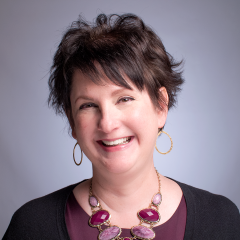Regional Branding: Let's DO This!
by Lisa Sisley on February 12, 2014
Around these parts — the central Flint Hills-ish — for the last few years, regional branding and marketing has been like the weather. Everybody talks about it, but nobody does anything about it. Well, to their credit, the big thinkers who planned the 2014 Leaders Retreat, a joint venture of the Wamego, Junction City and Manhattan chambers of commerce, decided to tackle the topic head-on this year. And they asked Kristin and me to do the talking. You can download our presentation here, should you be inordinately drawn to PowerPoints. Or read on, McDuff, for a summary.
First, I took a few minutes to get some definitions straight, because it helps if, when people talk about something, they all agree on what they're talking about. If you follow me. So I defined various elements of branding including logos (wordmarks, icons and combos), monikers (nicknames such as "The Little Apple" or "Sin City") and taglines ("Keep Austin Weird" or "The World Grows Here").
I also touched on what a brand is. It's not just a logo (lest you were confused). It's "the sum total of all things": word of mouth, personal observation, interactions with locals, media, visual identity, and communications and advertising.
And a campaign is the steps you take to share the brand with the world. It's got goals, a budget, an established duration and tangible deliverables.
Then Kristin got to the heart of the matter. She'd done a ton of research on regional marketing efforts big and small, both well-funded and volunteer-driven. What she found were several successful models. Guess what? Regions have a lot of options when it comes to collaborating. Which is the exciting part. And the scary part.
A Formal Entity
She started with "Cleveland+," a partnership between Cleveland, Akron, Youngstown and an 18-county area in Ohio. A well-funded and well-staffed effort ($2 million budget, two full-timers), Cleveland+ aims to attract new business, garner positive national attention, and attract talent. Doing good research and getting regional buy-in was huge: Even the Akron contingent agreed after seeing the data that the brand should be Cleveland, but all parties now consistently emphasize the region — "the plus" — rather than the city. Today, private corporations kick in money each year, but grants and tax funding got the ball rolling.
An Ad Hoc, Nimble Approach
On the other end of the spectrum, "Portland-Vancouver USA" aims to create jobs (they were hit hard by the recession) and push the region as a top-25 metro. Frustratingly for them, Vancouver, Wash. was often confused with Vancouver, British Columbia in Canada, and was also overshadowed by Portland. The regional tagline, "Land Here. Live Here." refers to the appeal that the regional quality of life has for professionals, and to the availability of land for site selectors. A licensing fee to use the logo is the primary means of funding for this volunteer-driven effort, along with grants and as-needed private donations.
A Partnership of Organizations and Businesses
Finally, "Iowa's Creative Corridor" is an amalgamation of elements of both other approaches. Started at a regional business retreat in 2009, this seven-county area focuses on its authentic affiliations with the Iowa Writers' Workshop, the University of Iowa, many arts organizations and 30 Fortune 500 businesses. They began with an internal focus on collaboration and buy-in, highlighting their arts, sciences and technology resources. They celebrate innovative business thinking and hope to recruit young, talented "creative-class" professionals. Sixteen organizations pledge financial support, and over 50 groups and businesses have shared time, ideas and talent.
Results?
The well-heeled effort of Cleveland+ has resulted in 67 new companies for that region, and 6000 new jobs. The Portland-Vancouver USA campaign has caused many people to shift their thinking and language—from referring to "Greater Portland" to calling it "the Portland-Vancouver metro." And Iowa's Creative Corridor is new but is building a strong social media presence, recently hosted a very popular week of activities, and has engaged a lot of 20- to 40-year-olds in the process.
Final Thoughts
No matter how we decide to approach regional branding, a few elements are key.
- Get real. We should leverage our true assets, not those we wish we had. The Iowa group originally tried a "technology corridor" approach that flopped. Too many other technology corridors out there. That message didn't showcase their true strengths.
- Get buy-in. We need to build upon the good work of the annual Leaders Retreats, the strong efforts of the Flint Hills Regional Council and the many informal alliances and collaborations of organizations and businesses in the area. All players must be heard. All naysayers must be answered.
- Get smart. Money anxieties derail many a dream. And they shouldn't. We need to have a little faith that we will find creative and sustainable ways to fund our regional marketing campaign.
So let's keep the momentum going for this effort. We've all done a lot of legwork on this already. Let's keep it moving!

